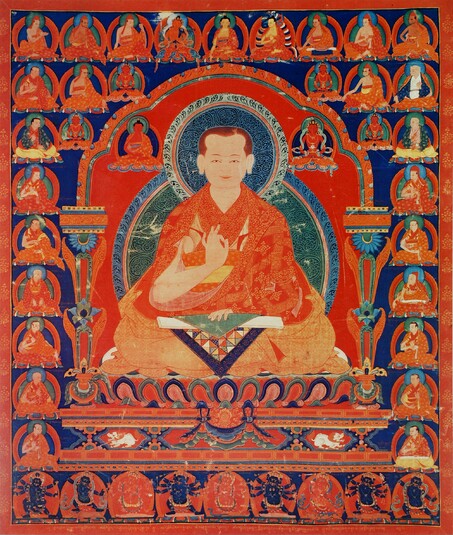
Item: Teacher (Lama) - Mawai Sengge
| Origin Location | Central Tibet |
|---|---|
| Date Range | 1500 - 1599 |
| Lineages | Sakya |
| Material | Ground Mineral Pigment on Cotton |
| Collection | Private |
| Painting School | Ngor |
Classification: Person
TBRC: bdr:P431
??? Mawai Senge, (1367-1449): also known as Rongton or Rong Tikpa Sheja Kunrig. He founded the famous Tibetan Nalendra monastery. (See HAR #200627). ???
 Biographical Details (TBRC P431).
Biographical Details (TBRC P431).
Jeff Watt 7-2003
Nor, Peintures du Monasterie de Nor (list of image plates)
![]()
Biography:
Rongton Sheja Kunrik (rong ston shes bya kun rig) was born into a Bonpo family from Gyelrong (rgyal mo rong), a district of Amdo.
As a boy, Rongton studied Bon teachings with his father. At age eighteen he moved to central Tibet to study at Sangpu Neutok (gsang phu ne'u thog) monastery, a highly esteemed center of Kadampa and Sakya learning, especially known for the study of logic. There he took his bodhisattva vows with Rinchen Namgyel (rin chen rnam rgyal, 1318-1388) and studied the sutras, tantras, and Buddhist sciences with great determination. In particular, he studied the lineage of Ngok the Translator (rngog lo), Madhyamaka (dbu ma), the Eastern Vinaya (smad lugs) tradition, Abhidharmakośa (mngo mdzod), Prāsaṅgika Madhyamaka (dbu ma thal 'gyur ba), and the Higher Abhidharma (mgnon pa gong ma) with various masters. By the age of twenty Rongton had achieved an extraordinary level of knowledge and renown and was given the name Mawai Sengge (smra ba'i seng se), after the manifestation of Padmasambhava associated with Mañjuśrī. At twenty-two when he approached the completion of his foundational studies he was given the name Shakya Gyeltsen (shakya rgyal mtshan).
Sheja Kunrik studied with Yakton Sanggye Pel Yakton Sanggye Pel (g.yag ston sangs rgyas dpal, 1350-1414), Sonam Zangpo (bsod nams bzang po, 1341-1433), Sengge Gyeltsen (seng ge rgyal mtshan, d.u.), and Zhonnu Gyeltsen (gzhon nu rgyal mtshan, d.u.), among others.
Over the course of his long career, Rongton taught at Sangpu Neutok and also traveled throughout U-Tsang and Ngari, visiting sacred places and teaching many students as he went. During his travels he earned the reputation of a great teacher particularly in regards to the sutras although he also taught extensively on Vajrayāna.
Rongton's students included Drakpa Zangpo (grags pa bzang po, d.u.), Zhonnu Pel (gzhon nu dpal, 1392-1481), Shakya Chokden (shakya mchog ldan, 1428-1507), Yonten Gyatso (yon tan rgya mtsho, 1443-1521), Gorampa Sonam Sengge (go rams pa bsod nams seng ge, 1429-1489), and the Sixth Karmapa, Tongwa Donden (karma pa 06 mthong ba don ldan, 1416-1453), Konchok Gyeltsen (dkon mchog rgyal mtshan, 1388-1469), Namkha Pelzang (nam mkha' dpal bzang, d.u.) as well as many illustrious others.
Although he put remarkable effort into teaching, Rongton was also a great yogic practitioner. To attest to Rongton's yogic mastery, one biographical account tells that when Rongton's big toenail fell off it turned into a substance like mother of pearl.
Like his root teacher, Yakton Sanggye Pel, Rongton was a great master in the transmission of Abhidharmakośakārika and was famous for his knowledge of the Prajñāpāramitā teachings, on which he composed a commentary called shes rab kyi pha rol tu phyin pa'i lam nyams su len pa'i rim pa mun sel sgron me. Under Sanggye Pel he also studied and composed a commentary on Haribhadra's Clear Meaning Commentary (Skt. Sphutartha; 'grel pa don gsal), a celebrated work on Maitreya's Abhisamayālaṅkār. Rongton was the author of a commentary on Maitreya's Great Vehicle Treatise on the Sublime Continuum called theg pa chen po rgyud bl ma'i bstan bcos legs par 'grel ba. His written works also include dbu ma rtsa ba'i rnam bshad zab mo'i de kho na nyid snang ba, a work on the Root of the Middle Way.
There are a number of biographical works about Rongton, including two composed by his student Shakya Chokden and one by Namkha Pelzang, as well as one written in the twentieth century by Ngawang Tsultrim (ngag dbang tshul khrims).
Rongton founded Penpo Nalendra ('phan po na len dra) monastery, located north of Lhasa, in 1436 when he was sixty-nine years old.
Bibliography:
Dung dkar blo bzang 'phrin las. 2002. Dung dkar tshig mdzod chen mo. Beijing: China Tibetology Publishing House.
Grags pa 'byung gnas and Rgyal ba blo bzang mkhas grub. 1992. Gangs can mkhas grub rim byon ming mdzod. Lanzhou: Kan su'u mi rigs dpe skrun khang.
Gser mdog pan chen shakya mchog ldan. 1975. Rje btsun thams cad mkhyen pa'i bshes gnyen shakya rgyal mtshan dpal bzang po'i zhal snga nas kyi rnam par ngo mtshar dad pa'i rol mtsho. Thimphu: K. Topgyay. Vol 16, pp. 299-378.
Roerich, George, trans. 1976. The Blue Annals. Delhi: Motilal Banarsidas, p. 340.
Dominique Townsend has a PhD in Tibetan Studies from Columbia University and is currently teaching at Barnard College. Published February 2010.
[Extracted from the Treasury of Lives, Tibetan lineages website. Edited and formatted for inclusion on the Himalayan Art Resources website. July 2015].
Subject: Margapala/Lamdre (Lotus Pair 12)
Tradition: Sakya Teachers
Subject: Margapala/Lamdre Lineage [1] (Ngor set)
Teacher: Mawai Sengge (Lama)
Subject: Composition - Registers





